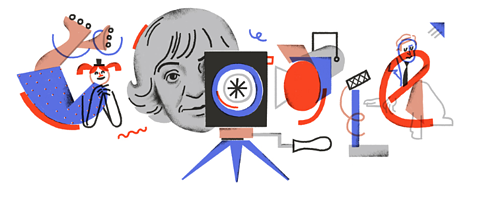This year, the Google Doodle celebrates its 25 year anniversary – I wonder if there will be a Doodle to note the occasion?
Now synonymous with the Google logo on the home page and in the SERP, who can imagine Google without the Doodle?
What Is A Google Doodle?
A Google Doodle is a limited edition illustration incorporating the Google logo on its home pages to reflect birthdays, holidays and celebrated days.
The search engine company first came up with this idea back in 1998, before the company was even incorporated.
Founders Larry Page and Sergey Brin attended the infamous Burning Man festival and wanted to show they were out of the office. They decided to ‘tweak’ the Google home page logo as a statement to reflect they were at the festival. And, after that, the idea progressed.
It was a few years before another Doodle was created for Bastille day by the then intern Dennis Hwang. After this, Hwang was appointed ‘Head Doodler’ and the Google Doodle began to make a regular appearance.
Google Doodles are now created by a team of illustrators and engineers and used for things like commemorating achievements (both within and outside the company), honoring the birthdays of important people, and celebrating holidays.
To date, there have been more than 5,000 unique doodles on Google’s homepages worldwide. From Lego, Pac Man, SOPA, Keith Haring, London tube, Sir Isaac Newton, Alan Turing to the The Great Wave Off Kanagawa and more.
Here are some of our favorites and the most notable Doodles from the last 25 years.
The Best Google Doodles From The Last 25 Years
1. The Original
The very first Google Doodle was published in the summer of 1998.
It consisted of the festival’s iconic stick figure drawing behind an “O,” to notify users that the founders were “out of office.”

And from this simple idea, a company tradition was born.
2. Thanksgiving, 1998
Less than three months after the official launch of Google, the search engine added its first-ever holiday Doodle in honor of Thanksgiving on November 26, 1998.
3. Halloween, 1999
These days, Google releases a new Doodle nearly every day – but it took almost a year before a new logo featuring pumpkins to replace the “O’s” showed up on the search engine on October 31, 1999.
4. Bastille Day, 2000
On July 14, 2000, Google released its first-ever Doodle made to run exclusively outside the U.S.
Honoring Bastille Day, it added red and blue fireworks and the French Tricolor to the company’s logo.
5. Shichi-Go-San, 2000
The second international Doodle was released on November 15, 2000, to honor Shichi-Go-San, the traditional Japanese rite of passage festival.
It appeared exclusively in Japan.
6. Canada Day, 2001
On July 1, 2001, Google began publishing Doodles celebrating national holidays, beginning with Canada Day, the celebration of the anniversary of the Great White North’s Constitution Act.
Other countries including South Korea and Switzerland followed.
7. Claude Monet’s 161st Birthday
The first Doodle that’s dedicated to an artist, this version of the Google logo was published on November 14, 2001.
It used the “Water Lilies” painter’s trademark impressionist style to celebrate Claude Monet’s birthday.
8. Dilbert Doodles
Between May 20-24, 2002, Google released a series of five Doodles featuring characters from the beloved comic strip “Dilbert.”

9. Valentine’s Day, 2007
Using a chocolate-dipped strawberry to represent the second “g” and “l” in its name, the Doodle design gave the impression that “Googe” was missing a letter.

This Doodle ran on February 14, 2007
10. Lego Bricks
From constructing elaborate cityscapes to superhero vehicles, precarious towers to families of dogs, if you can imagine it, there’s a way to build it with Legos.

In honor of the 50th anniversary of the world’s most famous plastic building brick, on January 28, 2008, the Google homepage was taken over by a logo constructed of Legos.
11. Sir Isaac Newton’s 367th Birthday
The first HTML5-powered animated Doodle was published on January 4, 2010, in honor of the birthday of Issac Newton.
12. PAC-MAN
In honor of the 30th anniversary of the world’s first great video game, Google released a Doodle honoring PAC-MAN on May 21, 2010.

This Google homepage-embedded game lets users take over the eponymously named hero to navigate a maze spelling the search engine’s name, eating the dots while trying to avoid ghosts.
13. John Lennon’s 70th Birthday
On what would have been the singer’s 70th birthday on October 8, 2010, the Google Doodle featured a short animated film paired with his song “Imagine.”
14. “The Great Wave Off Kanagawa”
On October 31, 2010, in honor of the birthday of artist Katsushika Hokusai, Google’s Doodle was a nod to his most famous print, and perhaps the most famous Japanese work of art, “The Great Wave off Kanagawa.”

The search engine used the waves to form the “G” in its name in the famous 17th-century woodblock.
15. Jules Verne’s 183rd Birthday
On February 8, 2011, Google paid homage to science fiction writer Jules Verne with an interactive Doodle inspired by his novel “Twenty Thousand Leagues Under the Sea.”
16. Robert Indiana – Valentine’s Day, 2011
On February 14, 2011, we saw the unveiling of a Google Doodle inspired by artist Robert Indiana’s iconic “LOVE” image.

17. Charlie Chaplin’s 122nd Birthday
On April 16, 2011, a short film Doodle was released to mark the 122nd birthday of “The Little Tramp.”
18. Les Paul’s 96th Birthday
Google let users virtually shred the guitar with a Doodle honoring guitarist, songwriter, luthier, and inventor Les Paul on June 9, 2011.

19. First Day of Summer/Winter By Takashi Murakami
On June 21, 2011, the Google Doodle was a yin and yang of the seasons in honor of the solstice.
Created by Japanese artist Takashi Murakami, the Northern Hemisphere’s Doodle celebrated the first day of summer, while the Doodle in the Southern Hemisphere marked the first day of winter.
20. SOPA/PIPA Protest
This Doodle from January 18, 2012 is not whimsical or interactive, but instead was used by Google to protest web censorship.

Part of a series of coordinated protests against two proposed laws in the United States, the Stop Online Piracy Act (SOPA) and the PROTECT IP Act (PIPA), this Doodle employed a simple but powerful design of a black bar to take a stance against censoring the web.
21. Keith Haring’s 54th Birthday
American pop artist Keith Haring used a background in New York City’s graffiti subculture to create some of the most recognizable works of the 1980s.

To celebrate what would have been his 54th birthday, the May 4, 2012, Google Doodle employed his trademark style to form the company name on search pages.
22. Alan Turing’s 100th Birthday
Honoring the legacy of computer pioneer Alan Turing on his 100th birthday, the Google Doodle for June 23, 2013, let users interactively decode the company’s logo.
23. Bob Ross’s 70th Birthday
The October 29, 2012, Doodle featured everyone’s favorite painting instructor Bob Ross making some “happy little trees” in honor of what would have been his 70th birthday.

24. Halloween, 2012
Google has released so many Halloween Doodles over the years that it can be hard to pick a favorite.
While 2011’s stop-motion pumpkin carving and 2017’s ghostly cartoon are strong contenders, if we have to choose just one, it has to be Halloween 2012.

Published on October 31, 2012, this Doodle features a spooky soundtrack with fun, interactive monster animations.
25. London Tube
The London Tube celebrated its 150th anniversary on January 9, 2013.
In honor of the first underground journey, which took place between Paddington and Farringdon on the Metropolitan Railway, Google created a Doodle.

Mimicking the style of the underground map, Google’s name is spelled out by the various tube lines.
26. Luis Barragan’s 111th Birthday
Mexican Google celebrated the 111th anniversary of the birth of architect and engineer Luis Ramiro Barragan on March 9, 2013, with a Doodle featuring one of his most iconic creations, Cuadra San Cristobal.
27. St. Patrick’s Day, 2013
There’s one day per year on which everyone wears green and has the luck of the Irish – St. Patrick’s Day.

In honor of the feast day of the patron saint of Ireland, the Google Doodle for March 17, 2013, featured an animated line of traditional Irish dancers wearing shirts that spelled out the search engine’s name.
28. Ella Fitzgerald’s 96th Birthday
No vocalist has ever embodied the spirit of jazz so much as Lady Ella.
Known for her tone, timing, diction, and scatting ability, she is one of the most influential singers of all time.

The Google Doodle used to honor the Queen of Jazz was constructed from cut paper to mimic the effect of stage lighting and theatricality.
29. 100th Anniversary Of The First “Loop De Loop”
On September 9, 1913, Russian pilot Pyotr Nesterov completed the first aerial “loop de loop.”
One hundred years later, Google’s Doodle honored his achievement.
30. Shakuntala Devi’s 84th Birthday
Though she had died earlier in the year, Google honored the “human computer” on November 4, 2013, with a Doodle featuring her likeness and the search engine’s name spelled out as if on a calculator.

31. Dr. Who’s 50th Anniversary
You don’t need a time machine to play the fun interactive game Google released as a Doodle on November 23, 2013, to mark the 50th year of Dr. Who.
32. 2014 Winter Olympics
Rather than use the traditional Olympic Rings design, Google opted to create a Doodle marking the beginning of the Winter Olympics on February 7, 2014, while subtly taking a stand against host country Russia’s anti-LGBT laws.
33. Nezha Conquers The Dragon King
On May 30, 2014, Chinese Google featured a Doodle in honor of the 35th anniversary of the epic fantasy film “Nezha Conquers the Dragon King.”

34. Doodle 4 Google, 2014
For its seventh annual Doodle 4 Google competition, the search engine asked students to draw an invention that would make the world a better place.
11-year-old Audrey Zhang of New York won out of more than 100,000 entrants and had her drawing featured on June 9, 2014.
35. World Cup, 2014
If there is one thing Brazil is known for, it’s being absolutely mad about soccer (or football, to you non-Yanks).
The Google Doodle that ran in the South American country on July 4, 2014, celebrated the World Cup with an animation that changed the Brazilian flag into a soccer ball.
36. Perseid Meteor Shower
Every August, a spectacular meteor shower known as the Perseids lights up the night sky.
On August 11, 2014, the Google Doodle featured a beautiful animation using stars to spell out the company’s name.

37. Discovery of Lucy
The November 24, 2015, Doodle was inspired by the 45th anniversary of the discovery of the most complete Australopithecus afarensis (a fossil of an early human ancestor) ever found.
38. Beethoven’s 245th Birthday
To mark the “Fur Elise” composer’s 245th birthday, the Google Doodle for December 17, 2015, asked users to reassemble his famous Fifth Symphony.
39. Wilbur Scoville’s 151st Birthday
Fans of spicy foods everywhere will be familiar with the scale invented by American pharmacist Wilbur Scoville to measure the heat of chili peppers.

In honor of the Scoville scale creator’s birthday on January 2022, 2016, Google released an interactive Doodle that included facts about some of the most famous (and infamous) types of chilis, as well as a game in which you could try to defeat them with cooling ice cream.
40. Leap Day, 2016
Celebrating the extra day we get every four years, the Doodle from February 29, 2016, used a spring theme.
41. Juno Reaches Jupiter
On August 5, 2011, a spacecraft named Juno was launched from Cape Canaveral.
Nearly five years later, it finally reached its destination, entering a polar orbit of Jupiter to photograph the gas giant and collect data that will provide clues about its formation.

In honor of this achievement, Google’s Doodle for July 5, 2016, employed a two-dimensional style familiar to retro gamers.
42. 44th Anniversary Of The Birth Of Hip Hop
On August 11, 1973, at a party in the Bronx, DJ Kool Herc began playing and looping the instrumental breaks from songs – thus giving birth to a new style of music the world would come to know as hip hop.

To mark the 44th anniversary of this momentous event, Google released a Doodle narrated by rap pioneer Fab 5 Freddy that allowed users to mix and scratch tracks with a virtual crossfader.
43. The American Solar Eclipse Of 2017
While solar eclipses are relatively common, occurring roughly every 18 months, they usually occur over the ocean or less densely populated areas.
So, the total solar eclipse that occurred over the United States on August 21, 2017, was a big deal.

Google commemorated this event with an animated Doodle featuring two extraterrestrial creatures watching the eclipse from the comfort of their spaceships.
44. Coding For Carrots
During Computer Science Education Week, 2017, the Google Doodle on December 4 was a tribute to 50 years of kids’ coding.

The combined work of the Doodle team, the Google Blockly team, and researchers from MIT scratch, this game invited users to use code blocks to help a rabbit collect carrots.
45. Gabriel Garcia Marquez’s 91st Birthday
Often considered one of the most important authors of the last 100 years, Gabriel Garcia Marquez was a Nobel Prize-winning novelist known for works in magical realism.

Google honored what would have been the Colombian writer’s 91st birthday on March 6, 2018, with a colorful Doodle evoking the lush, vibrant Amazon jungle town Macondo from his famous work, “One Hundred Years of Solitude.”
46. World Cup, 2018 – Day 11
Any of the Google Doodles from the 2018 FIFA World Cup in Russia could have made this list, so choosing just one was difficult.
Featuring guest artists from all 32 participating countries, each sought to provide a representation of life in their homeland.

Day 11 is a good representative of the project, including art from England, Panama, Japan, Senegal, Poland, and Colombia – all of which played on this day, June 24, 2018.
47. Baseball
Few things are more American than baseball – which is probably why Google opted for a Doodle game featuring the nation’s pastime for the Fourth of July, 2019.

In this timing-based game, the user clicks on a swing button to help a team of foods rack up runs against an opposing peanut team.
48. Museo Del Prado
Madrid’s Museo del Prado first opened its doors on November 19, 2019.
Two hundred years later, the world-famous art museum got its very own Google Doodle.
49. Tatyana Lioznova’s 96th Birthday
Google commissioned Moscow-based artists Sveta Mullari to create a Doodle celebrating Tatyana Lioznova, a rare female director in the Soviet movie industry.
It was published on July 20, 2020.

50. Celebrating Johannes Gutenberg
Few people have had as large an impact on the human species as Johannes Gutenberg, inventor of the printing press.
The April 14, 2021, Doodle celebrated his legacy.
51. Lunar New Year, 2022
Throughout the world, people celebrate the new year based on the ancient Chinese lunar calendar.

To symbolize this time of new beginnings and ancient traditions, the February 1, 2022, Doodle welcomed the Year of the Tiger with a representation of that animal, as well as traditional foods, lanterns, and flowers.
52. Valentine’s Day, 2022
Valentine’s Day is another holiday that Google always does right. One of the cutest has to be the one from 2022.

This February 14, 2022, Doodle allows you to help two love-struck hamsters find their way to one another via user interaction.
53. Doodle Champion Island Games
In the summer of 2021, Google published a series of Doodles in which users took control of feline avatars to explore a world filled with sports mini-games, boss fights, and side quests.

The ultimate goal was to defeat each sport’s champion and collect seven sacred scrolls – a fun way to amuse yourself on the web.
54. Celebrating Marie Tharp
Marie Tharp was an American geologist whose work helped prove the theory of continental drift.
She was honored with a Doodle on November 21, 2022, the 20th anniversary of being named one of the 20th century’s greatest cartographers by the Library of Congress.
55. Lunar New Year, 2023
Google marked the beginning of a new lunar year on January 22, 2023, with three Doodles marking the important Asian holiday.

A Doodle For Every Occasion
One of the most fun things about Google Doodles is that they keep pushing the envelope.
From beautiful works of art to interactive games, the search engine company continually finds innovative new ways to spice up its homepages.
And even better, they’re open to suggestions.
If you have an idea for a Doodle, email doodleproposals@google.com to share it.
If you’re lucky, you may even see it brought to life.
More Resources:
- The Great Big List of 50+ Google Easter Eggs & How to Access Them
- An SEO Guide to Google Advanced Search Operators
- History of Google Algorithm Updates
Featured Image: GoodStudio/Shutterstock


